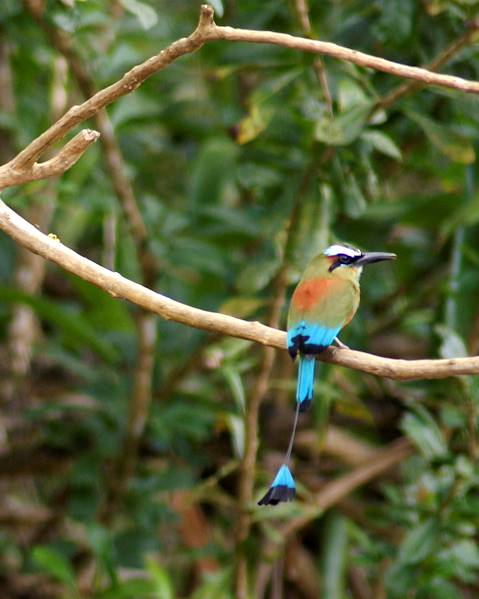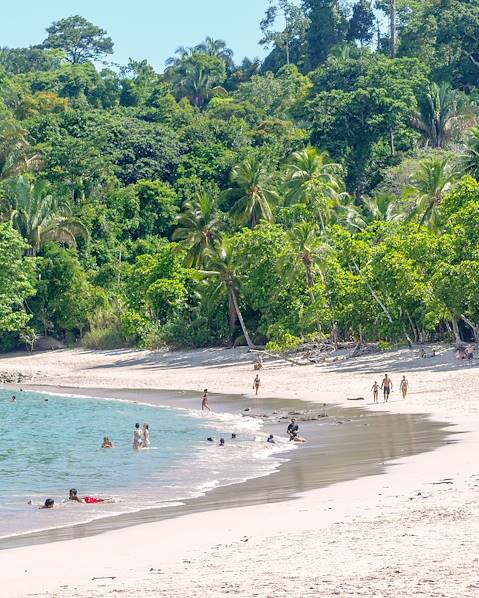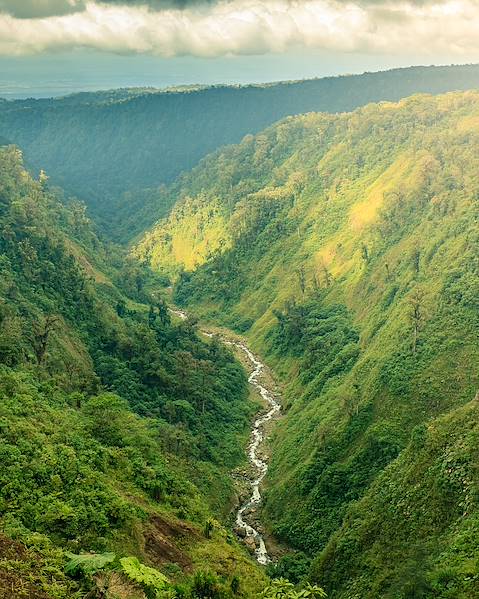The list of things to do in Costa Rica is a lengthy one, especially if you’re a wildlife-lover and outdoor enthusiast. Cloud forest canopy tours and volcano treks will be music to your ears if you’re keen to get outside and make the most of the country’s abundant nature (which we strongly suggest you do). Read on for our (whittled down) selection of things to do in Costa Rica…
Volcano Tours
There are two highly impressive volcanoes within easy reach of the capital, San José, and both are well worth a day trip for anyone staying in Costa Rica for longer than a flying visit. Just over an hour's drive from San José, you’ll find Irazu – Costa Rica's highest volcano – complete with brightly coloured houses and quaint little farming villages on its vegetated slopes, which give way to a more desolate, almost lunar, landscape nearer the summit. Although wildlife is scarce due to the regular volcanic activity in the area, the national park is home to a variety of small mammals, as well as toucans, quetzals and hummingbirds.
The views from the top on a clear day are fantastic and you might even be lucky enough to catch a glimpse of both the Pacific and Caribbean coasts. The pea-green and rust-red rain-fed mineral crater lakes at the summit are equally impressive, although the rims can be fairly perilous so it's best to stay a good distance away and hike with a local guide.
Top tip? Make sure to get to the volcano as early as possible, since it can be shrouded in cloud by the early afternoon. If it does look cloudy when you arrive, it is still well worth driving up to the top as the summit is often above the cloud line.
Holding the titles of the world's largest active volcano, the world's most easily accessible active volcano and the world's largest geyser, it is easy to see why Poas Volcano is one of the Central Valley's top attractions. An hour and a half from San José, the enormous Poas Volcano measures a staggering mile in width and is over 900 feet deep.
The views from the top are spectacular on a clear day, but as is often the case in this part of the country, mist and cloud can cover the crater at a moments notice and we strongly advise you to get there as early as possible to see it at its best. The turquoise-hued waters of the sulphurous crater lakes are continuously changing due to the constant (albeit very mild) volcanic activity, but the frequent eruptions are, by and large, little more than a bit of steam and muddy water.
There are several short, unchallenging trails leading to the craters, making this one of the most accessible things to do in Costa Rica. The Crater Overlook trail takes you from the visitors centre to the main crater, while the Sandero Botos trail leads to a smaller, extinct crater and is lovely for a picnic. For bird enthusiasts, the National Park is home to over 80 species of birds, including hummingbirds, the clay-coloured thrush (Costa Rica’s national bird), and the resplendent quetzal. It is also home to a unique squirrel – the yellow-green squirrel – which is endemic to the park.
Canopy Tours
Swoop through the cloud forest with the greatest of ease on a zip-wire, and discover the rainforest from a hanging bridge high up in the canopy. Hitting speeds of up to 40 miles an hour, you will be propelled down a series of ten cables through the Monteverde Rainforest for the ultimate adrenaline high. Between rides, you'll stop at different observation platforms which tower above the canopy layer offering superb panoramic views of the surrounding forest; this is one of the best things to do in Costa Rica if you’re a certified adrenaline-junkie.
Another rather slower paced way to explore this rare ecosystem is on the treetop walkway tour. Accompanied by an expert guide, walk over eight bridges suspended high in the virgin rainforest, which connect almost two miles of trails and offer the perfect viewpoint for observing the biodiversity of the canopy.
Why We Love It
The cables measure up to 524ft in height and with the longest cable over 2500ft in length, the Sky Trek is certainly not for the faint hearted.
Riding Safari in Costa Rica
Undoubtedly the most scenic and fun way to travel between Arenal and Monteverde is on horseback, crossing straight over the old mountain trails which separate the lake from the cloud forest. After leaving the town of La Fortuna, you will be driven to Lake Arenal for a boat crossing. Horses and guides will be waiting on the far shore, and it is then a four-hour ride through rivers and lush forests up to the town of Monteverde. Climbing up to 3,600ft, over steep mountain passes, enjoy stunning views of the lake and volcano in the east and the pristine cloud forest to the west.
The ride can also be done in the opposite direction, descending down through the forests from Monteverde to the Lake Arenal Basin. Whichever way you choose to go, this peaceful ride makes a great alternative to a car transfer and is the best way to experience the natural wonders of this part of Costa Rica.
Why We Love It
The horses travel slowly due to the terrain covered during the ride, so you don’t need to be an experienced rider to enjoy this excursion. Your luggage will be taken to your end destination by vehicle and will be waiting for you on arrival.
Surfing the Nicoya Peninsula
With warm waters, stunning beaches and fewer people than many of the surf spots in Costa Rica, the Nicoya Peninsula is as close to surfing perfection as you can get. Conditions are excellent all year round, although for the absolute best, the dry season between December and April is the time to go. The stretch of coast know as Mal Pais, meaning 'bad lands' in Spanish is anything but bad, with excellent surfing to suit all levels. Beginners can get to grips with their board in the mellow waters around El Carmen, while the more seasoned pros can ride the fast hollow waves 15 minutes up the coast in Santa Teresa.
We can arrange private lessons with qualified instructors during your stay. With some stylish accommodation in the area, you'll be well-rested before you take to the waves and can indulge in a little luxury at the end of a day on the water.
Why We Love It
The surfer's salute of fist with thumb and little finger spread, while used universally, has become a Costa Rican greeting embodying the Ticos' philosophy of Pura Vida - a commitment to celebrating a peaceful way of life.
Tocori Waterfalls Riding Tour
Discover the private Tocori Biological Reserve, the Tocori waterfalls and the beautiful beaches of Manuel Antonio National Park on a riding trip with a charming local guide and naturalist. Exploring the region on horseback is the perfect way to cover a good distance, while learning about the local – and in many cases unique – flora and fauna as you go. Some previous riding experience is generally required, but please note this isn't going to be a high octane ride for pros only, rather a gentle walk and occasional trot.
Why We Love It
Make like a real Tico (Costa Rican) cowboy on a fun and informative ride, learning about the region's wildlife and extraordinary plant life, including several medicinal herbs, and enjoying Tico treats en route.
Turtle Nesting Tour
Tortuguero National Park is home to some of the world's finest nesting sites for endangered green turtles. This nocturnal guided tour offers the chance to see the females – who weigh around 300 lbs – haul themselves up the beach (the same one where they were born), dig a nest and lay their eggs before returning to the sea. Turtles tend to lay their eggs at night to avoid predators and avoid the sand being too hot – to minimise disturbance your guide has a red light torch, to which the turtles are not sensitive. Using this light you can see the entire process, and marvel at one of the most wonderful sites in nature; undoubtedly one of most special things to do in Costa Rica.
Why We Love It
The turtle nesting season runs from July to September, which isn't necessarily the prime time to be in Costa Rica, but seeing turtles laying their eggs in a well-protected National Park is an extremely heart-warming experience.
















